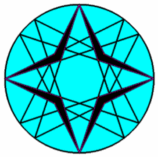QL-Co-1: Inscribed Quadrilateral Conics
5th Line Conics
By adding an extra line to the set of 4 basic lines of a Quadrilateral we get a configuration of 5 lines. Let L5 (u:v:w) be a random 5th line. Five lines do define a unique (inscribed) conic just like 5 points do define a unique (circumscribed) conic.
Equation Conic in CT-notation
Tx2 x2 + Ty2 y2 + Tz2 z2 + 2 Ty Tz y z + 2 Tz Tx x z + 2 Tx Ty x y = 0
where:
Tx = l u (m w – n v)
Ty = m v (n u – l w)
Tz = n w ( l v – m u)
CT-Coordinates Center
(Ty + Tz : Tx + Tz : Tx + Ty)
CT-Coefficients Asymptotes
Asy-1(Tx (Tx + Ty) (Tx + Ty + Tz) – (Tx + Ty) √ [-Tx Ty Tz (Tx + Ty + Tz)] :
-Ty(Tx + Ty) (Tx + Ty + Tz) – (Tx + Ty) √ [-Tx Ty Tz (Tx + Ty + Tz)] :
-Tz(Tx – Ty) (Tx + Ty + Tz) + (Tx + Ty + 2 Tz) √ [-Tx Ty Tz (Tx + Ty + Tz)] )
Asy-2(Tx (Tx + Ty) (Tx + Ty + Tz) + (Tx + Ty) √ [-Tx Ty Tz (Tx + Ty + Tz)] :
-Ty(Tx + Ty) (Tx + Ty + Tz) + (Tx + Ty) √ [-Tx Ty Tz (Tx + Ty + Tz)] :
-Tz(Tx – Ty) (Tx + Ty + Tz) – (Tx + Ty + 2 Tz) √ [-Tx Ty Tz (Tx + Ty + Tz)] )
Equation Conic in DT-notation
Ty Tz x2 + Tz Tx y2 + Tx Ty z2 = 0
where:
Tx = n2 v2 – m2 w2 Ty = l2 w2 – n2 u2 Tz = m2 u2 – l2 v2
DT-Coordinates Center
(Tx : Ty : Tz)
DT-Coefficients Asymptotes
Asy-1(Tz (Ty2 + Tx Ty + Ty Tz – √ [-Tx Ty Tz (Tx + Ty + Tz)] :
-Tz (Tx2 + Tx Ty + Tx Tz + √ [-Tx Ty Tz (Tx + Ty + Tz)] :
(Tx + Ty) √ [-Tx Ty Tz (Tx + Ty + Tz)])
Asy-2(Tz (Ty2 + Tx Ty + Ty Tz + √ [-Tx Ty Tz (Tx + Ty + Tz)] :
-Tz (Tx2 + Tx Ty + Tx Tz) – √ [-Tx Ty Tz (Tx + Ty + Tz)] :
-(Tx + Ty) √ [-Tx Ty Tz (Tx + Ty + Tz)])
Properties
- QL-Co1 (Inscribed Parabola) and QL-Co2 (Inscribed Midline Hyperbola) are both examples of 5th Line Conics.
- The Center of a 5th Line Conic is always a point on the Newton Line QL-L1.
Center constructed inscribed Conics
It is also possible to define an inscribed Quadrilateral Conic by the 4 basic lines of the Reference Quadrilateral and the Center of the conic. This appointed center should be a point on the Newton Line (see properties 5th Line Conics).
Let N = (d : e : f) be a point on the Newton Line and be appointed as the center of an inscribed quadrilateral conic.
Equation Conic in CT-notation
(-d+e+f)2 x2 – 2 ( d+e–f) (d–e+f) y z
+ (d-e+f)2 y2 – 2 (-d+e+f)(d+e–f) x z
+ (d+e–f)2 z2 – 2 (-d+e+f)(d–e+f) x y = 0
4 Points of tangency in CT-notation
- ( 0 : d+e–f : d–e+f )
- ( d+e–f : 0 : -d+e+f )
- ( d–e+f : -d+e+f : 0 )
- ( (d+e–f)2 m2+2 ( d–e+f) f n2 + 2( d+e–f) (d–e+f) m n :
(d+e–f)2 l2 +2 (-d+e+f) f n2 + 2(-d+e+f) (d+e–f) l n :
(d+e–f) ((d–e+f) l2+(-d+e+f) m2) )
Equation Conic in DT-notation:
e f x2 + d f y2 + d e z2 = 0
4 Points of tangency in DT-notation
( -d l : e m : f n )
( d l : -e m : f n )
( d l : e m : -f n )
( d l : e m : f n )
When N = QL-L1 ^ QL-L6 then one of the axes of the Center Conic coincides with the Newton Line (note Eckart Schmidt).
Properties:
- When N = QL-L1 ^ QL-L6 then one of the axes of the Center Conic coincides with the Newton Line (note Eckart Schmidt).
Estimated human page views: 484
